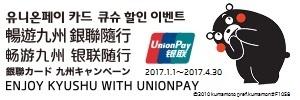ARTICLE
Dancing All Night
14/12/2015
- Author : Ellen
- Country of Origin : USA
- Age : 20's
- Gender :female
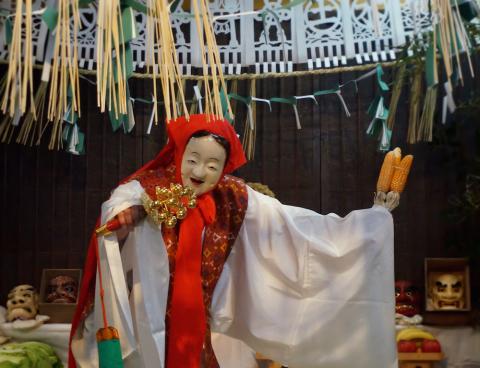
Every winter, the tiny mountain town of Takachiho in Kyushu’s Miyazaki prefecture hosts an all-night dance party. But it’s not what you think--Takachiho’s yokagura festival is an 800 year-old tradition, and all of the gods and goddesses of Japan are invited. Every weekend from mid-November to early-February, local men take turns performing in a sacred dance marathon that lasts from dusk till dawn. Kagura, a series of 33 ancient Shinto folk dances, reenacts the Japanese myth of the sun goddess Amaterasu. According to legend, she was so upset by the violent antics of her brother, the storm god, that she hid herself in a cave and plunged the world into darkness. The whole pantheon of deities gathered to try to find a way to lure her out of the cave; eventually, another goddess called Ame-no-Uzume led them all in a dance (including a strip-tease) so uproarious that it made Amaterasu peek out of the cave to see what all the commotion was about--and the world was once again illuminated by her radiance. Kagura dancing can be found all over Japan, but Takachiho’s all-night kagura is something special--in fact, it was designated as one of Japan’s Intangible Folk Cultural Properties in 1978. Takachiho kagura is said to be close to the art’s original form because of the town’s distinct connection to the Amaterasu myth; Takachiho is the actual location of the cave where Amaterasu hid.
Yokagura is also special to me because for the last two years I’ve called Takachiho home. Since I'm planning on moving back to America next summer, I knew that this year would be my last chance to experience the remarkable ceremony. So I invited a few friends--Japanese, American, and British--to share one last night of dancing in this magical place.
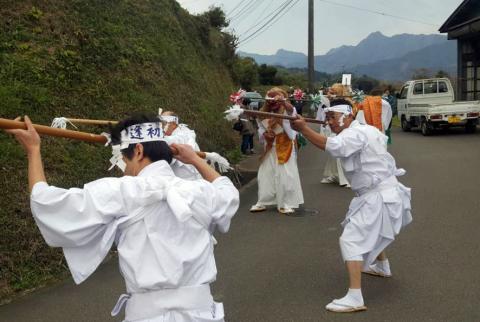
The festivities usually start at around 4:00 in the afternoon with the maikomi, a procession that brings the gods down from the local shrine for the duration of the night. Coming back from an afternoon of sightseeing at Takachiho’s gorgeous gorge, my friends and I stumbled across the maikomi procession by accident. To our surprise, our car was stopped in the middle of the road by an auspicious-looking pair of half-lions half-dragons snaking down the street. Following them was a crowd of white-robed locals wearing colorful masks and carrying the portable altar from the shrine and a huge taiko drum. Kids jangled bells and we slowly inched our car down the road behind the revelers as they headed to the kagurayado, the hall where kagura is performed. Traditionally, different families each year would be chosen to host yokagura in their houses. This was a huge honor because it was essentially like inviting the gods as guests into your home for the night. These days, it's a treat to see yokagura performed in private houses, but the festival is more commonly held in public community centers--which is where the lively group was headed on the day we joined. The streets and rice paddies along the way were lined with shimenawa (straw ropes decorated with paper zigzags that mark off the road as a sacred path for the deities), and all of the neighbors had come out of their farmhouses to watch the parade go by.
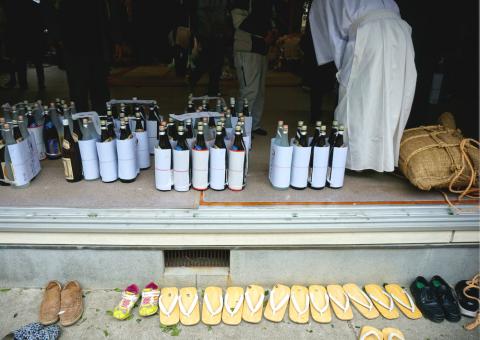
We decided we’d need to go home first and fill our bellies with warm things if we were going to have the stamina to watch the dancing into the wee hours of the night. Some locals joined us for a dinner of steaming nabe, a stew cooked in a big earthenware pot. It was filled with savory morsels of Takachiho beef and vegetables grown by my friend Seiko, who has the ability to coax carrots as sweet as candy out of the soil. Enjoying a bounty of homegrown foods seemed a fitting meal for the occasion, since the main inspiration for the annual kagura ritual is to thank the gods for a prosperous harvest and pray for another successful year.
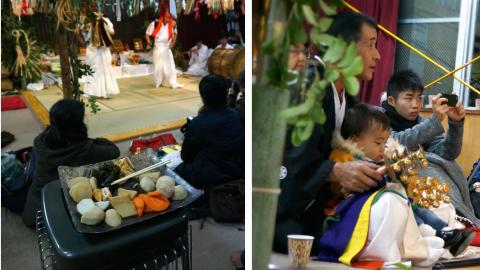
When we were all full to the point of groaning, we bundled up and headed into the dark, stuffing foot-warmers into our shoes. The path was lit with candles flickering inside bamboo lanterns, and as we approached, the distant beating of the drum grew louder. Outside the community center, young men warmed their hands around a crackling bonfire. Though it was already after midnight, the hall was still full of people of all ages sitting on the floor and leaning against the beams--old ladies wrapped in blankets, babies dozing in their moms’ arms, white-haired men saying "Kanpai!" ("Cheers!") with cups of kappozake, hot sake poured from a hollow stalk of bamboo. We were met with a hearty "You kita ne!", which is how you say "Welcome!" in the Miyazaki dialect. The room had been completely transformed; in the center was a stage, a square of tatami mats decorated with fresh green branches of the holy sakaki tree and surrounded by a canopy of intricately cut erimono (white paper flags unique to Takachiho). Visitors can sign up to make their own erimono--my apartment is decorated with them!
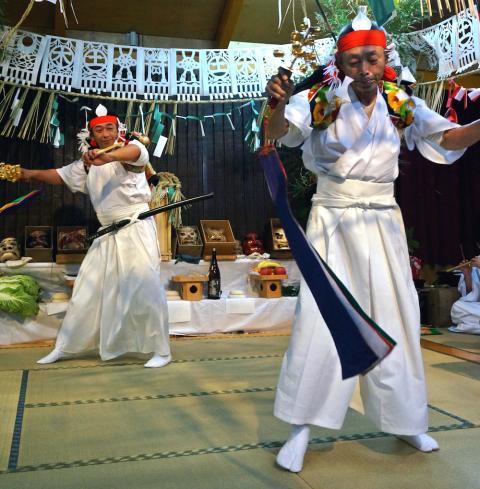
All eyes were on the five dancers circling slowly in the center of the stage, each one wearing the ferocious mask of a deity and carrying offerings of corn, barley, and wheat. They wove in and out in practiced synchronicity as the drums thumped a steady dun-dakka-dun and the bamboo flute repeated a hypnotic trill. We slid into an empty spot at the back of the room just as the rosy-cheeked, red-kerchiefed Ame-no-Uzume took the stage and the dance came to a climax, the drum beating faster and faster and the flute reaching piercing heights.
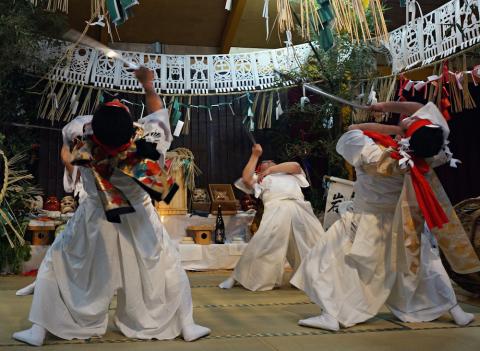
Just because the routines are sacred doesn’t mean they’re somber. On the contrary, as the night went on the dances become more and more thrilling. Around 2:00 in the morning, four dancers performed a daring sword show, holding not onto the handles but onto the tips of each other’s blades, tying and untying themselves into knots, whirling around like dervishes, and swinging the swords over their heads in a death-defying display--especially considering the shochu (Kyushu’s liquor of choice) they’d probably been drinking plenty of.
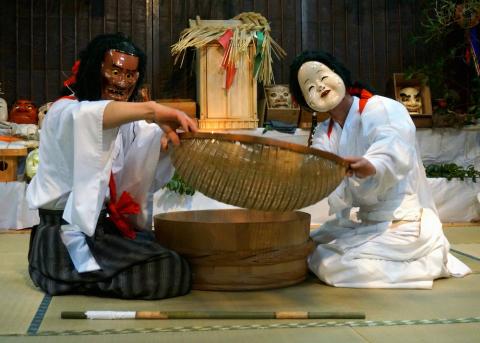
Everyone was looking forward to an early-morning dance called the “Go-Shintai”. It tells the story of a pair of gods named Izanagi and Izanami, who symbolize marital harmony. Their portrayal of wedded bliss isn’t exactly sugar-coated, though. In the dance, the husband and wife are hard at work making sake... but when the other one isn’t looking, they each tip-toe through the crowd looking for a lover to seduce.
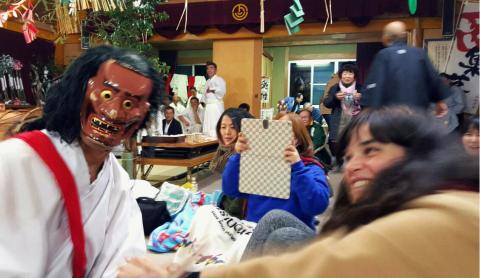
The husband character scanned the audience in search of a catch--and leapt right onto my lap! He did a flirtatious little jig with me as my friends and I died laughing, until his furious wife rushed over and shooed him back to the stage, swatting at him with her kimono sleeve. The dance ended happily, with the couple reunited and drinking a lot of sake and--well, no spoilers, but it was maybe good thing that most of the kids in the audience had nodded off at that point. They woke up instantly, though, when the dancers scattered pink and white squares of handmade mochi to the delighted audience.
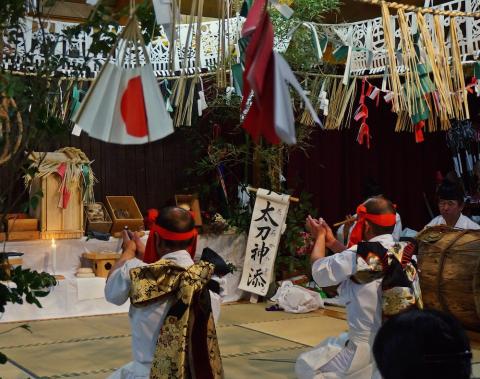
As we munched on our mochi (they were even better when we took them home and toasted them to gooey perfection), it struck me that watching kagura feels like a completely different experience from watching a professional performance. The dancers practice all year long, and they’re talented (a Takachiho kagura troupe even toured in Brazil last year). But a lot of the charm is in seeing the regular Joe--or in this case Jouji--transformed into a deity for one night. I loved watching the normally buttoned-up town office guys suddenly doing somersaults while brandishing swords, and seeing the pride of the spectators as their relatives and friends carried on this treasured tradition. The choreography isn’t written, but its secrets are passed down from generation to generation, and when you watch yokagura it’s easy to see the ties that the people of Takachiho maintain to their heritage. Staying up all night together, sharing snacks and hot drinks, you feel welcomed into the unbroken line that has been performing this ritual here for centuries. My friend Kozue explained this feeling: she said that she didn’t mind the cold of the December night because she could feel the warmth of the dancers and the audience. The community’s effort to put on this annual ceremony is especially palpable when the epic celebration comes to a close around 9:00 AM and the whole crowd is invited to join the dancers for the “Kurioroshi-no-Mai”. In this dance, everyone tugs on ropes connected to the stage, and the deities are said to ascend back to the world of the gods by dancing along these ropes all the way up to heaven. With one last prayer and many bows, the whole festival is finally over--until next year. But in the space of the sudden silence, you’ll hear the trancelike rhythm of the kagura drums echoing on.

Tips for kagura visitors:
- It’s easy to see Takachiho’s love of kagura in their unofficial mascot, a super-strong god named Tajikarao who stars in one of the most exciting of the 33 kagura dances. With a bright red face, fierce eyes, an intimidating nose, and wild hair, you can’t miss him. No matter which direction you enter Takachiho from, you’ll be greeted by Tajikarao; his image is painted on garages, guards tunnels, and is immortalized in statues all around the town. There are even gigantic stone masks of his and Uzume`s faces at the highway rest stop, and smiling out from their huge mouths makes for a great souvenir photo. On your next visit, keep an eye out and see how many Tajikaraos you can spot.
- The full yokagura ceremony is performed in a different location each weekend from mid November to early February, so check the schedule on the Takachiho town website to find out where it’s being held: http://takachiho-kanko.info/event/yo_schedule.php
- If you can’t visit during the official yokagura season, you can still experience kagura! Takachiho Shrine puts on a selection of four dances every night of the week at 8:00 PM, and tickets are ¥700.
- Locals are extremely welcoming to visitors, but remember that kagura is a sacred ceremony and be respectful of this.
- Bring a small donation. In exchange for ours, we each received our own Shinto wand called a gohei.





![Kyushu Tourism Information [ Japan ]](/blogcontest/img/common/bnr_onsen_island.png)

